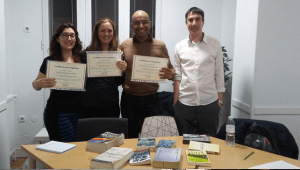by Brian Collins
I was 28 years old when I started teaching English in 2009. My TEFL career has led me to places such as Saudi Arabia, Qatar, Ecuador, Poland, France and various cities in Spain, and taught me aspects of the English language I wanted to learn for years, however, didn’t even know existed.
I was born and grew up in Ireland and like many native English speakers my childhood grammar education was practically non-existent. Yes I learnt what a verb, adjective and noun were, I learnt the differences between their, there and they’re, which a lot of my friends still don’t know, but structures like the present, past, future, perfect, simple, continuous, weren’t taught during my schooldays.
Of course I could use these structures in speaking but I could not define them, I could not explain their components, I could not explain how sentences are formed.
This non-education created problems for me in my early twenties while studying print journalism in college.
I graduated knowing I had a talent for writing;
writing introspectively and about society came easily to me, however, the projects I handed in throughout my college years were returned with red-ink corrections.
One of my teachers recommended that I get Eat, Shoots and Leaves. I read it and with all respect to Lynne Truss the book didn’t help. In retrospect I wonder why a grammar class wasn’t run during my college years and the only reason I can think of is that the teachers didn’t know how to teach the subject.
At the age of 15 I started reading a lot. I fell in love with words and the sentence, with authors who analysed and tried to understand society, and at the age of 17 I realised I loved writing—I actually remember the moment I realised this.
Every writer, published or otherwise, knows the love of writing, getting lost in your mind, trying to figure out and write your thoughts into sentences, paragraphs and full length stories, making sense of or fictionalising what is happening around you.
The literature I started reading is what I consider ‘gateway literature’. Kerouac, Hunter S. Thompson, Orwell, Ginsberg, Wilde and then I moved onto Hemingway, Joyce, Dostoyevsky, Didion, Marquez, Woolf, and then onto Tolstoy, to name but a standard few.
I vividly remember reading, A Catcher in the Rye when I was 17 and at around page thirty there was a sentence with had had.
I read had had several times and concluded it must have been a typo, why would had had be together, I thought!
Over the years and before I went in-depth into studying grammar I came across this use of the past perfect repeatedly while reading and it always confused me.
In 2008, a year before I moved to Madrid and started teaching English, I completed a thirty-week creative writing course in the Irish Writers’ Centre, Dublin. I handed in four pieces of writing of 2000 words to be critiqued by the class and teacher. As in university, people enjoyed my style of writing, my voice, but once again my pages were returned with red ink all over them.
My teacher told me straight out I’d never get published if I didn’t sort out my grammar so I signed up for grammar grinds with a secondary school teacher.
Shortly after completing the grammar grinds I moved to Madrid, did a two-week TEFL course and completed English Grammar in Use intermediate, then started teaching. My initial students had upper-intermediate levels. My employer viewed me as a good conversational teacher so I didn’t teach any lower levels during my first year.
By Christmas I had already started preparing materials about what I was interested in –– literature. I had a one-to-one business class each Monday and Wednesday in my student’s office in the outskirts of Madrid. The office was on the 15th floor and had a great view of the mountains north of the city.
I had read For Whom the Bell Tolls and remembered the novel is set in the mountains outside Madrid. I asked my student if he would like to read parts of the novel, and for the last 20 minutes of each class we read For Whom the Bell Tolls while looking out at the mountains. This was my first experience of using literature in an EFL classroom.
Since those initial days teaching I have worked around the world, completed the CELTA and DELTA Module One. However, oddly enough, I tried to do the DELTA before the CELTA. Nowadays I do a lot of examiner work and I have designed and teach my own courses.
So, this brings me to where I am today and why I’m writing this article. I felt I had to explain my reasons for becoming an English language teacher before I could truly explain the courses I’m designing and teaching.
 I set up The English Course Madrid in 2016. The first course I designed is English Literature 1, which is a ten-week, twenty-hour course for upper-intermediate/advanced levels. My students read a short story of between ten and twenty pages for homework each week. The stories haven’t been graded, however, to help comprehension, a glossary is included with each story. I chose the stories very carefully, I don’t want to overwhelm my students with literature which would be difficult for even native English speakers to comprehend.
I set up The English Course Madrid in 2016. The first course I designed is English Literature 1, which is a ten-week, twenty-hour course for upper-intermediate/advanced levels. My students read a short story of between ten and twenty pages for homework each week. The stories haven’t been graded, however, to help comprehension, a glossary is included with each story. I chose the stories very carefully, I don’t want to overwhelm my students with literature which would be difficult for even native English speakers to comprehend.
The first story of English Literature 1 is a personal essay by Joan Didion and is about her experience of moving to and living in New York. She describes the streets of New York, some landmarks, her life at that time and her thoughts. The next story we read is a long-form article about the protests in Tiananmen Square in 1989. While reading, I ask my students to note down five phrases from each story, phrases that catch their attention, phrases they would like to memorise.
Reading is the best way for learners to notice language, language they’ve already been exposed to and are starting to commit to memory.
As the course reaches its final weeks, the language of the stories becomes more complicated, for example, we read Street Haunting by Virginia Woolf.
This is one of my favourite personal essays, however, I had to read this story a few times before I truly understood everything in it, therefore English language learners will certainly find it difficult. We also read a twenty-five page James Baldwin essay, which is taxing because of its length and Baldwin’s sentences are loaded with observations and meaning; not one word is disregarded in his writing. I tell my students if they find parts of a story difficult, continue reading and during the discussion stage of the lessons everything will be cleared up, and it usually is.
The stories on English Literature 1 all have a 1st person narrative and are mostly non-fiction, whether a personal essay, a long-form article or a personal history. We do read a short story by James Joyce, but it’s one of his manageable stories from Dubliners.
I chose the 1st person narrative as it’s my favourite form of literature, it’s also the style I write when writing creatively. The most common story type on the course is the personal essay, which when done well, is packed full of amazing insights, stories and language. The aspect my students enjoy most about English Literature 1 is the choice of stories and the introduction to authors they would not have read otherwise.
I started The English Course Madrid with the idea of providing comprehensive, high-quality courses for learners of English—materials and a curriculum that have been determined and tested before the first day of the course. I’ve worked for many English academies, some very good and some not so good, and the thing I always found lacking was that there was never a complete course to teach, only a book to work from.
Some of my colleagues who had been working as English language teachers for years would still be panicking to prepare their next lesson, designing materials one hour before the start of class, and then discarding those materials afterwards.
I want to get away from this wasteful and time consuming approach to materials development, I want brilliant materials that I will use again and again, adapting them as I go forward, and to provide a complete course with clear objectives.
As the level of English increases in Madrid, largely due to the BEDA (Bilingual English Development & Assessment) programme, many secondary school students are graduating with a level of B2 and above. At the The English Course Madrid we use materials to complement this level increase and we plan to run literature courses with native speakers and advanced English learners in the same classroom.
We plan to bridge the gap between native and non-native speakers and adapt the language classroom to a literature one.




